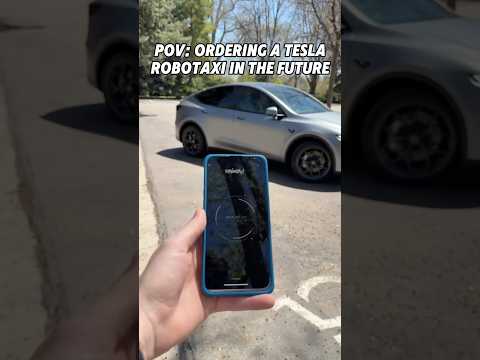
- Tesla plans to launch its first fleet of autonomous robotaxis in Austin, aiming to redefine urban mobility with driverless technology.
- Federal regulators, particularly NHTSA, are pressing Tesla for clarity on how its self-driving vehicles will handle adverse conditions such as fog, rain, glare, and other unpredictable challenges.
- Tesla is collecting extensive real-world data through human test operators and collaborating with emergency responders to ensure readiness.
- The rollout comes amid heightened market pressure, industry skepticism, and concerns about automated vehicle safety.
- The results of Tesla’s robotaxi program could have a significant impact on autonomous vehicle regulations and the future of self-driving technology.
Thick fog rolls across the highways of Texas as dusk settles, obscuring headlights and turning the familiar into the uncertain. For Tesla, this isn’t just weather—it’s the ultimate test. The company, synonymous with innovation and controversy, now finds itself at the eye of a regulatory storm as it prepares to unleash its long-promised fleet of robotaxis in Austin next month.
Federal safety officials are demanding unambiguous answers: How will Tesla’s driverless cars see through blinding rain, navigate pools of glare, or react when the world outside shifts in unpredictable ways? The National Highway Traffic Safety Administration (NHTSA) has zeroed in on these pivotal questions, tying them to prior crashes involving the company’s advanced driver-assistance system.
Elon Musk’s confidence remains unshaken. At a recent investor summit, he painted an audacious vision—millions of autonomous vehicles crisscrossing American cities, promising riders the luxury of sleep and an arrival at their destinations with not a hand on the wheel. To make this dream a reality, Tesla has mobilized a shadow army: hundreds of human test operators weaving through Austin’s bustling streets, gathering “critical miles” of data and stress-testing the infrastructure needed to support a city-wide robotaxi rollout.
Meanwhile, engineers have worked late into the Texas night, orchestrating training drills with emergency responders, and fine-tuning Tesla’s pilot ride-hailing app for its most important debut yet. Every detail matters, because this isn’t just another launch—it’s a make-or-break moment for the brand’s future.
Some industry insiders, however, sound alarm bells. Experts who have guided the rise of rival self-driving tech argue that real safety comes from rigorous fail-safes—not hope or hype. Public scrutiny is growing as the stakes climb: with Tesla’s profits battered and its share price climbing on hope, the market’s patience isn’t infinite.
The next few months will shape not just a company’s destiny, but potentially the very laws that govern our roads. The success or failure of Tesla’s bold robotaxi experiment could redraw the boundaries between promise and peril in autonomous driving. The takeaway? True innovation is about more than dazzling promises—it’s about delivering safety in the loneliest, foggiest mile.
Tesla’s Robotaxi Gambit: What You Need to Know Before They Hit Texas Roads
Introduction
Tesla’s imminent robotaxi launch in Austin, Texas, has captivated both the automotive industry and tech enthusiasts. Thick fog, unpredictable weather, and regulatory scrutiny have transformed otherwise routine roads into a high-stakes proving ground for Elon Musk’s boldest vision yet: a future driven by fully autonomous, hands-free vehicles. But beyond the headlines, there are deeper questions around safety, technology, and the real-world readiness of robotaxis that demand answers.
—
Additional Key Facts Tesla’s Robotaxi Launch Leaves Unexplored
1. Technology Behind Tesla’s Autonomy
– Camera-Only Approach: Unlike many competitors (such as Waymo and Cruise), Tesla relies exclusively on cameras and neural networks, having eliminated radar and lidar from its full self-driving (FSD) hardware. This “vision-only” system has sparked significant debate among experts about its effectiveness, especially in low-visibility conditions like fog, rain, or darkness ([Source: MIT Technology Review](https://www.technologyreview.com/)).
– OTA Updates: Tesla vehicles receive frequent Over-the-Air (OTA) software updates, allowing the company to deploy bug fixes and new features rapidly. However, such updates have, at times, introduced new bugs or safety concerns, leading to recalls ([Source: NHTSA](https://www.nhtsa.gov)).
– Data Collection and AI Training: Tesla’s “shadow mode” allows the AI to observe drivers and hypothetical scenarios without taking control, using vast amounts of real-world data to iteratively improve its algorithms.
2. How-To: What to Expect as a Passenger
If you want to hail a Tesla robotaxi in Austin:
1. Install the Tesla app (with ride-hailing feature enabled).
2. Request pickup: Just as with Uber or Lyft, enter your location and destination.
3. Verification: Expect real-name verification and in-app passenger guidelines.
4. Ride Monitoring: Emergency stop and reporting features will be built into the interface for added passenger security.
3. Real-World Use Cases
– Airport Shuttles: Autonomous fleets can provide 24/7 coverage, especially beneficial for late-night or early-morning flights.
– Delivery Vehicles: Tesla could eventually use robotaxis for package delivery, competing with Amazon and FedEx robotics.
– Accessible Transportation: Potentially life-changing for seniors and people with disabilities.
4. Industry Trends and Market Forecasts
– Global Market Value: The autonomous vehicles market is projected to exceed $500 billion by 2030.[Source: Allied Market Research](https://www.alliedmarketresearch.com/)
– Competition: Tesla faces stiff rivalry from established players like Waymo (Alphabet), Cruise (GM), and Motional (Hyundai-Aptiv JV), many of which already have commercial AV pilots (but mainly restricted to sunny climates like Phoenix).
5. Reviews & Comparisons
– Waymo vs. Tesla: Waymo cars use a fusion of lidar, radar, and cameras, generally considered safer in fog and rain—Tesla’s vision-only approach has not yet proved its reliability in adverse weather.
– Pricing: Tesla has not provided exact robotaxi fare estimates, but Musk claims it will undercut existing ride-hailing by at least 60%.
6. Controversies & Limitations
– Regulatory Oversight: The NHTSA has ongoing investigations into several FSD-involved crashes. Legal frameworks for fully driverless operation remain inconsistent between cities and states.
– Emergency Handling: Critics argue that “edge cases” (e.g., rapid weather changes, erratic human driver behavior, or emergency vehicles on scene) remain unsolved by current AI models.
– Insurance & Liability: Unresolved questions remain over responsibility in the event of an accident—Tesla, the rider, or a third party.
– Public Perception: Polls show a majority of American consumers remain mistrustful of fully autonomous vehicles.
7. Security & Sustainability
– Cybersecurity: AV fleets are attractive targets for hackers. Tesla claims robust end-to-end encryption, but no system is fully immune ([Source: Wired](https://www.wired.com/)).
– Environmental Impact: If powered by renewable energy, robotaxis could dramatically reduce citywide emissions. However, increased rideshare convenience may also lead to higher total urban mileage (the so-called “rebound effect”).
8. Life Hacks: How to Spot a Robotaxi
– Look for distinctive sensor housings, badges, and the absence of driver controls in the front seats. New vehicles may feature external signage denoting autonomous mode.
—
FAQs
Q: How safe are Tesla’s robotaxis in bad weather?
A: While Musk insists the camera-based AI can handle adverse weather by training on billions of “corner cases,” external experts remain skeptical without independent third-party validation in real-world fog, rain, and glare.
Q: Will humans still supervise Tesla robotaxis?
A: For the initial Austin deployment, cars will likely have remote human monitoring, or in-cabin safety drivers, until regulatory bodies approve true Level 5 autonomy.
Q: How does Tesla’s service differ from Uber or Lyft?
A: Tesla’s system could offer lower cost through full automation and unique features (e.g., overnight charging, in-car entertainment), but early rides may have stricter protocols and limited service areas.
Q: What happens in an emergency or unexpected scenario?
A: Cars are programmed to pull over safely and alert remote operators; passengers will be able to directly contact support.
Q: How much will a Tesla robotaxi ride in Austin cost?
A: No official prices; industry analysts expect significant disruption at $0.40–$0.60 per mile (vs. average rideshare rates of $1–$2 per mile).
—
Actionable Recommendations & Quick Tips
1. Follow trusted sources on autonomous vehicles like the [NHTSA](https://www.nhtsa.gov) and major AV news outlets for independent safety updates as robotaxis launch.
2. Test ride cautiously—When the service launches, sit in the rear seat, use available emergency tools, and familiarize yourself with emergency protocols.
3. Register feedback to local officials and service providers. Your user experience helps shape public policy and deployment strategies.
4. Check your insurance policies and terms of service before riding—early adopters may need to sign waivers or acknowledgments.
5. Keep records (screenshots, ride logs) when using new tech services; report bugs and near-misses promptly.
—
Pros & Cons Overview
| Pros | Cons |
|——————————————-|—————————————————–|
| Potential for fewer accidents long-term | Current uncertainty in extreme weather conditions |
| Lower projected fares | Public mistrust, incomplete regulations |
| 24/7 on-demand mobility | Liability & insurance issues unresolved |
| Lower emissions (if powered by clean grid)| Hackability/cybersecurity concerns |
| Accessibility for non-drivers | Loss of driver jobs |
—
Final Take: Be Prepared, Stay Informed
Tesla’s robotaxi rollout in Austin represents a pivotal moment for autonomous transport. While the technology promises revolutionary changes, unresolved safety, regulatory, and ethical questions mean caution is warranted. As with any innovation, early adopters should stay informed, exercise vigilance, and actively participate in shaping how robotaxis integrate into everyday life.
For the latest on vehicle safety, visit NHTSA.
For broader tech news and industry trends, trusted sources include Wired, MIT Technology Review, and Allied Market Research.
This post You Won’t Believe What Could Decide Tesla’s Robotaxi Future This Summer appeared first on Macho Levante.

A cybersecurity specialist with a passion for blockchain technology, Irene L. Rodriguez focuses on the intersection of privacy, security, and decentralized networks. Her writing empowers readers to navigate the crypto world safely, covering everything from wallet security to protocol vulnerabilities. Irene also consults for several blockchain security firms.








